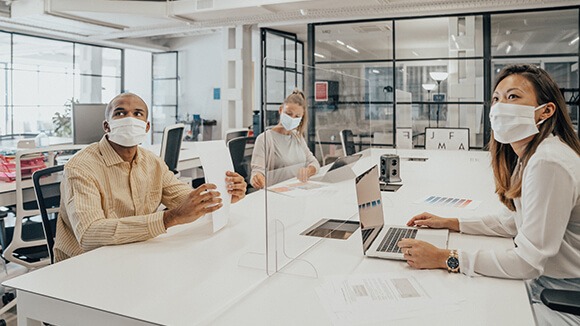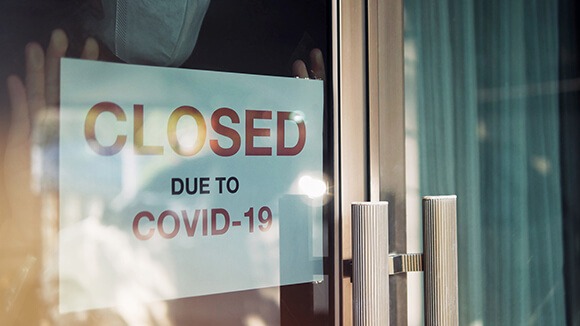Share This Story, Choose Your Platform!
In many cases, the way in which office spaces are used is going to change. The timeframe for workers returning to office buildings remains fluid and ultimately comes down to individual company decisions. In general, the schedule to return to offices en masse is likely to mirror the overall reopening of the statewide economy. The behavioral changes influenced by COVID-19 also remain uncertain. However, it is clear that health and safety concerns will take center stage at the workplace.
Environment, Health, and Safety (EHS) experts have begun re-examining the modern office workspace in the light of the pandemic and changing views on shared workspaces.
Returning To The Office Is Inevitable For Many Workers
Prior to the pandemic, offices were considered essential to raising productivity, fostering culture, and attracting talent. Securing prime office real estate was competitive in metropolitan cities. In recent years, many of those workplaces focused on collaborative, group environments. Office space requirements per employee witnessed a 20% decline. The upward trend in efficiencies was due to open floor plans with break-out rooms and other common amenities. Leaders in the technology and banking industries configured spaces to provide 65-70 sq. ft. per employee – a stark contrast from the recommended 100-120 sq. ft. per employee used by the architectural community for decades.
Did we squeeze in too many people too quickly? Based on a survey conducted by McKinsey, 80 percent of respondents confirmed they enjoyed working from home, while 41% believed they were more productive.
The COVID-19 outbreak has informed leaders that a good percentage of staff can work from home and deliver efficient results. This has raised questions regarding whether there is a need to maintain offices as before. It may also be suggested that businesses enlist new strategies to make offices more humane, productive, and safe.
EHS professionals say there are indications of what the future of office spaces should look like.
Enhanced Cleaning, Disinfection, and Elimination Measures
Employees will rightfully be expecting enhanced cleaning programs as they return to work. Frequent and effective disinfecting of public areas, such as receptions, pantries, dining areas, cafés, copy rooms, wellness rooms, and high-touch surfaces will have to be considered. An after-hours cleaning program, that attacks common areas with antimicrobial treatments to prevent germs and bacteria from circulating through touch, air, and water, is also fundamental.



Ease Office Congestion
Retrofit – Workstation enclosures and space delineation has become essential. It is important to understand how collaborative spaces need to meet current safety norms. Workstations should be set up with appropriate distance between them, while rules regarding the use of common area furniture will address maintaining proper social distances. Hygienic products for employees, such as hand sanitizers, antibacterial soaps, gloves, masks, and disinfectant wipes will become standard office supplies.
Reconfigure – It is crucial to ensure social and physical distancing by introducing new elements to the office. The introduction of plexiglass, panels, dividers, and wall enclosures will be key to re-purposing interior and exterior space for maximum occupancy. Traditionally, construction materials and fabrics were never considered amenities, however, post-pandemic they will have a spotlight. Offices built with construction materials that are antimicrobial, such as metallic and some laminate surfaces, as well as treated fabrics that can withstand strong cleaning treatments, will become more commonplace.
Re-invent – Other workplace amenities aided by technology will take on a prominent role. The inclusion of touchless dispensers, faucets, trash receptacles, paper towels, smart thermostats, and motion sensors will not only help reduce physical touch but prove to be cost saving at an imperative time. Think adaptability instead of permanence. Fluid instead of fixed.
Hospital Grade Elements
Eliminating pathogens being passed through droplets, physical proximity, and airborne transmissions will need to be targeted in design. The inclusion of quarantine rooms, oxygen supplies, and mask stations in office spaces have now reached beyond the realm of sci-fi and into reality.
HVAC Considerations
Airflow, air quality, and filtration will be held to a higher standard. Office buildings may require major re-engineering to avoid virus exposure. Floor or zone based segmentation of the air distribution system will be the norm in future building designs. High Efficiency Particulate Air (HEPA) filters are likely to become a standard feature. Air changes per hour may have to be increased to ensure higher levels of air purity.
Investing in Physical Safety
Having undergone a long period of restricted movement, the behavior of employees will change, and they will require more physical and mental space, not to mention personal safety.
Despite these changes, we will always need workspaces that foster collaboration, innovation, creativity, and a sense of belonging. There will always be a desire for amenities like artfully designed meeting spaces, eating areas, or physical activity centers like gyms.
The experts at CAM Property Services are here to assist you in making your workspace pandemic resilient. While every organization varies with regard to privacy policies and shared spaces, returning to work will clearly be changed in many ways. Our clients have access to a wide variety of property management services and solutions informed by our in-house EHS subject matter expertise to address their evolving needs.
About The Author: Pranav Heryani is an EHS & Sustainability Specialist. Among the next generation of environmental professionals, his projects have encompassed both local and international efforts toward green initiatives with practical sustainability for the commercial sector.
